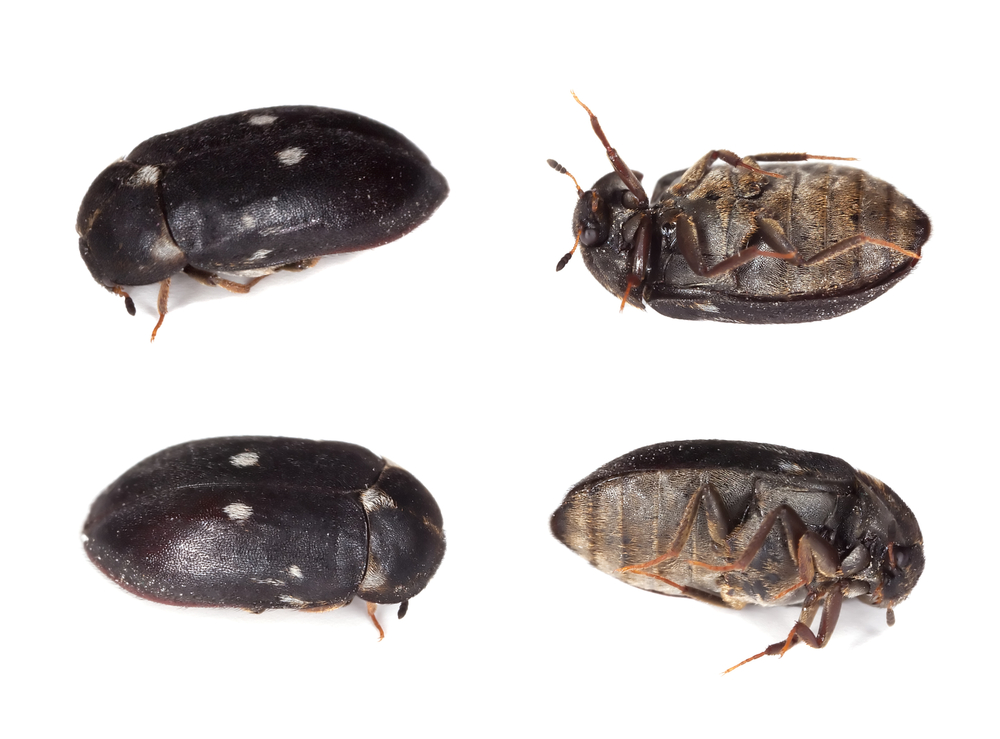Common Name: Black Carpet Beetle
Scientific Name: Attagenus unicolor (Brahm)
Class/Order/Family: Insecta/Coleoptera/Dermestidae
Metamorphosis: Complete
Introduction
 The black carpet beetle is the most commonly encountered and economically important of the carpet beetles. Its common name comes from its typical all black color. This species has been cited with respect to allergic responses in humans. It is found throughout the United States, but more commonly east of the Rocky Mountains and in the northern states.
The black carpet beetle is the most commonly encountered and economically important of the carpet beetles. Its common name comes from its typical all black color. This species has been cited with respect to allergic responses in humans. It is found throughout the United States, but more commonly east of the Rocky Mountains and in the northern states.
Recognition
Adults about 1/8-1/4″ (2.8-5 mm) long. Color dull dark brown to black. Antennae short, with 3-segmented club, end/terminal segment at least as wide and as long as preceding 2 combined (in males much longer, about 2 times). In addition, body elongate-oval, head more or less concealed from above, with a median ocellus, and tarsi 5-5-5. Larvae up to about 1-4″ (7-8 mm) long. Carrot-shaped, tapering towards rear. Color light brown to black. Covered with golden brown to dark brown hairs laying flat on body; dorsal/upper surface lacks tufts or spear-headed hairs; rear end with a long tuft of brown hairs nearly as long as body.
Similar Groups
(1) Other dermestid beetles (Dermestidae) not uniformly dull black, antennal club with last segment not at least as wide and long as preceding 2 combined. (2) Deathwatch/powderpost/anobiid beetles (Anobiidae) with antenna longer, if clubbed, then club asymmetrical (lopsided). (3) Other beetles with elongate-oval to nearly circular form lack a median ocellus.
Damages
Fabrics typically have much surface damage and holes here and there, but larvae can cause large irregular holes in material. Furs have the hairs cut at the base but no damage to the hide, giving the hide a bare appearance, and no webbing present. Larval castle/most skins are often present. Frass/droppings are minute, irregular in form, often the color of the material being damaged. The larvae may burrow through packaging materials when seeking food.
Biology
The female lays about 90 eggs (range 42-114) in lint which has accumulated in dark and secluded places such as behind and under baseboards, in cracks and crevices, in air ducts, etc. Eggs hatch in 5-16 days. Larvae usually molt 5-11 times, but may molt up to 20 times under unfavorable conditions, over a period of usually 166-330 days (range 166-639). The larva pupates in the last larval skin and pupation lasts 6-24 days. Developmental time (egg to adult) usually takes 177-370 days (range 177-679). Adults live for about 30-60 days.
Habits
Black carpet beetle larvae are general feeders on both animal and plant materials. Animal-origin materials include hair, fur, feathers, hides, horns, carcasses, and materials include cereal, stored grain, nuts, seeds, cayenne peppers, various meals, and processed foods, such as flour. On fabrics, larvae tend to surface graze but are quite capable of making small or large irregular holes. On furs, they cut the hairs at their bases and leave the hide undamaged. The larvae may burrow through packing materials to get to the contained food. The adults are found outside and active during warm weather.
They are found on flowers, particularly in the spring and especially on Spiraea spp., often eating the pollen. They can also be found int he nests of birds, rodents, and insects such as wasps, and around spiders. Inside, adults are often found at windows during the spring. The actual breeding areas can be quite diverse and may include unusual places such as wall/ceiling voids where cluster flies, box elder bugs, etc. Overwintered or yellow jackets, honey bees, etc. lived, feeding on the dead insects; rodent bait in attics, crawl spaces, and basements; electrical wire insulation in wall voids; wasp and hornet nests in attics or under eaves, bird nests built in or outside against buildings; light fixtures containing dead insects; behind and under baseboards where lint and pet hair accumulate; insulation which contains animal hair; etc.
The larvae tend to wander about feeding here and there, and can be found far from the primary infestation. When disturbed, the larva curls up and “play possum”. The adults are attacked to light upon emergence from the pupa, but avoid or shun light after mating. The larvae avoid or shun light.
Control
The key to controlling black carpet beetles is to find the primary source (s) of infestation and eliminate it/them. Besides the obvious carpeting, drapes, clothing, furs, fabric-covered furniture, and stored products, it may be necessary to check for the more unusual sites such as listed above. Ask the customer about flies in the winter, box elder bugs, rodent problems, bird’s nest, etc., both current and occurring in the past. The thorough inspection should be followed by good sanitation practices, and pesticide application when required. Museum specimens may be treated with the use of heat and/or cold if appropriate (be careful of possible damage to specimens) or with fumigants. Refer to the control section under the general treatment of fabric and paper pests for details.